Tax Residency, Barter Transactions, Deductions and Assessable Income
VerifiedAdded on 2023/05/29
|7
|1837
|372
AI Summary
This text discusses tax residency, barter transactions, deductions and assessable income in Australia. It covers relevant tax laws, cases and rulings to provide expert guidance on income tax regulations. The text is suitable for students studying income tax laws and regulations in Australia.
Contribute Materials
Your contribution can guide someone’s learning journey. Share your
documents today.

INCOME TAX
STUDENT ID:
[Pick the date]
STUDENT ID:
[Pick the date]
Secure Best Marks with AI Grader
Need help grading? Try our AI Grader for instant feedback on your assignments.
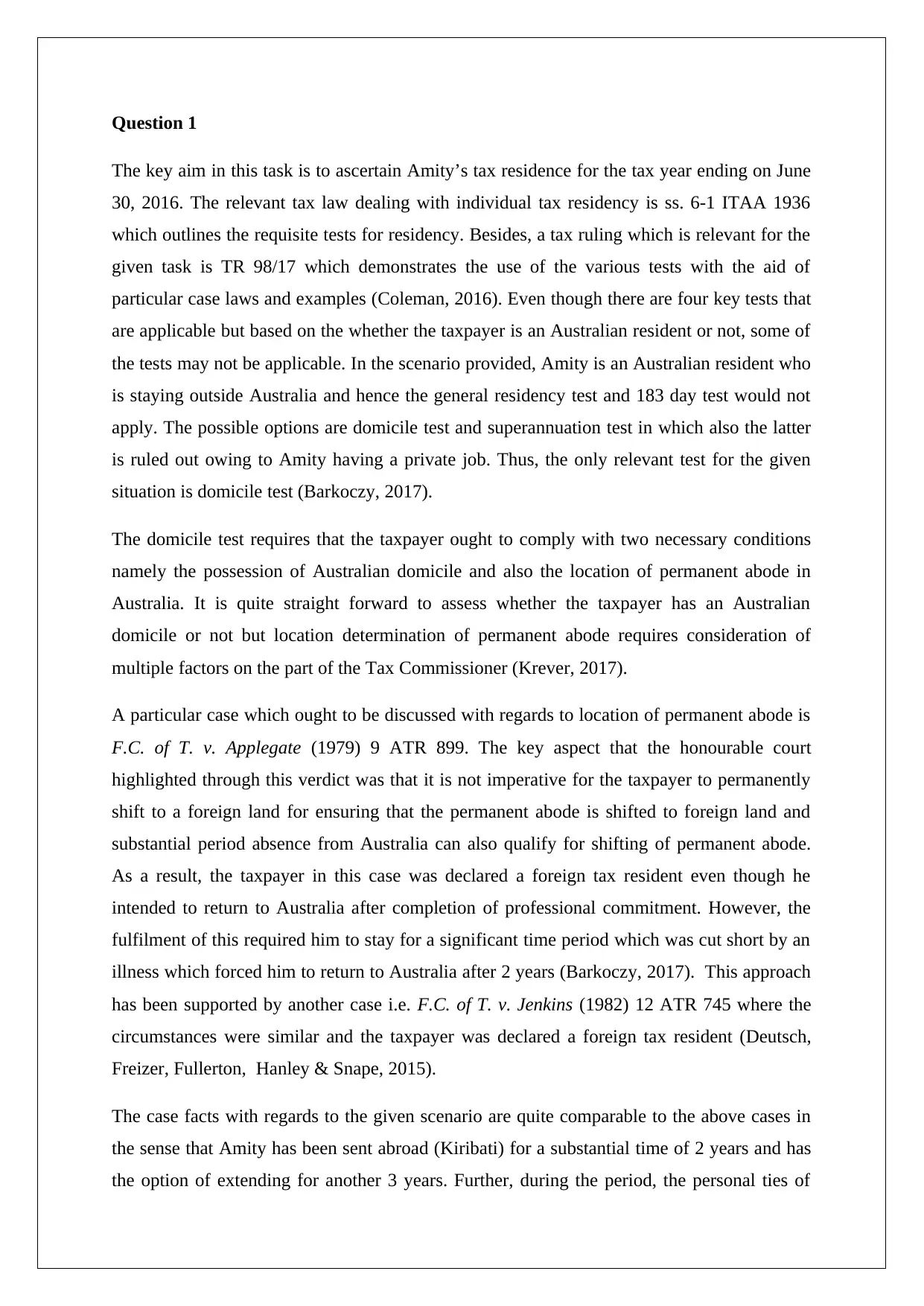
Question 1
The key aim in this task is to ascertain Amity’s tax residence for the tax year ending on June
30, 2016. The relevant tax law dealing with individual tax residency is ss. 6-1 ITAA 1936
which outlines the requisite tests for residency. Besides, a tax ruling which is relevant for the
given task is TR 98/17 which demonstrates the use of the various tests with the aid of
particular case laws and examples (Coleman, 2016). Even though there are four key tests that
are applicable but based on the whether the taxpayer is an Australian resident or not, some of
the tests may not be applicable. In the scenario provided, Amity is an Australian resident who
is staying outside Australia and hence the general residency test and 183 day test would not
apply. The possible options are domicile test and superannuation test in which also the latter
is ruled out owing to Amity having a private job. Thus, the only relevant test for the given
situation is domicile test (Barkoczy, 2017).
The domicile test requires that the taxpayer ought to comply with two necessary conditions
namely the possession of Australian domicile and also the location of permanent abode in
Australia. It is quite straight forward to assess whether the taxpayer has an Australian
domicile or not but location determination of permanent abode requires consideration of
multiple factors on the part of the Tax Commissioner (Krever, 2017).
A particular case which ought to be discussed with regards to location of permanent abode is
F.C. of T. v. Applegate (1979) 9 ATR 899. The key aspect that the honourable court
highlighted through this verdict was that it is not imperative for the taxpayer to permanently
shift to a foreign land for ensuring that the permanent abode is shifted to foreign land and
substantial period absence from Australia can also qualify for shifting of permanent abode.
As a result, the taxpayer in this case was declared a foreign tax resident even though he
intended to return to Australia after completion of professional commitment. However, the
fulfilment of this required him to stay for a significant time period which was cut short by an
illness which forced him to return to Australia after 2 years (Barkoczy, 2017). This approach
has been supported by another case i.e. F.C. of T. v. Jenkins (1982) 12 ATR 745 where the
circumstances were similar and the taxpayer was declared a foreign tax resident (Deutsch,
Freizer, Fullerton, Hanley & Snape, 2015).
The case facts with regards to the given scenario are quite comparable to the above cases in
the sense that Amity has been sent abroad (Kiribati) for a substantial time of 2 years and has
the option of extending for another 3 years. Further, during the period, the personal ties of
The key aim in this task is to ascertain Amity’s tax residence for the tax year ending on June
30, 2016. The relevant tax law dealing with individual tax residency is ss. 6-1 ITAA 1936
which outlines the requisite tests for residency. Besides, a tax ruling which is relevant for the
given task is TR 98/17 which demonstrates the use of the various tests with the aid of
particular case laws and examples (Coleman, 2016). Even though there are four key tests that
are applicable but based on the whether the taxpayer is an Australian resident or not, some of
the tests may not be applicable. In the scenario provided, Amity is an Australian resident who
is staying outside Australia and hence the general residency test and 183 day test would not
apply. The possible options are domicile test and superannuation test in which also the latter
is ruled out owing to Amity having a private job. Thus, the only relevant test for the given
situation is domicile test (Barkoczy, 2017).
The domicile test requires that the taxpayer ought to comply with two necessary conditions
namely the possession of Australian domicile and also the location of permanent abode in
Australia. It is quite straight forward to assess whether the taxpayer has an Australian
domicile or not but location determination of permanent abode requires consideration of
multiple factors on the part of the Tax Commissioner (Krever, 2017).
A particular case which ought to be discussed with regards to location of permanent abode is
F.C. of T. v. Applegate (1979) 9 ATR 899. The key aspect that the honourable court
highlighted through this verdict was that it is not imperative for the taxpayer to permanently
shift to a foreign land for ensuring that the permanent abode is shifted to foreign land and
substantial period absence from Australia can also qualify for shifting of permanent abode.
As a result, the taxpayer in this case was declared a foreign tax resident even though he
intended to return to Australia after completion of professional commitment. However, the
fulfilment of this required him to stay for a significant time period which was cut short by an
illness which forced him to return to Australia after 2 years (Barkoczy, 2017). This approach
has been supported by another case i.e. F.C. of T. v. Jenkins (1982) 12 ATR 745 where the
circumstances were similar and the taxpayer was declared a foreign tax resident (Deutsch,
Freizer, Fullerton, Hanley & Snape, 2015).
The case facts with regards to the given scenario are quite comparable to the above cases in
the sense that Amity has been sent abroad (Kiribati) for a substantial time of 2 years and has
the option of extending for another 3 years. Further, during the period, the personal ties of
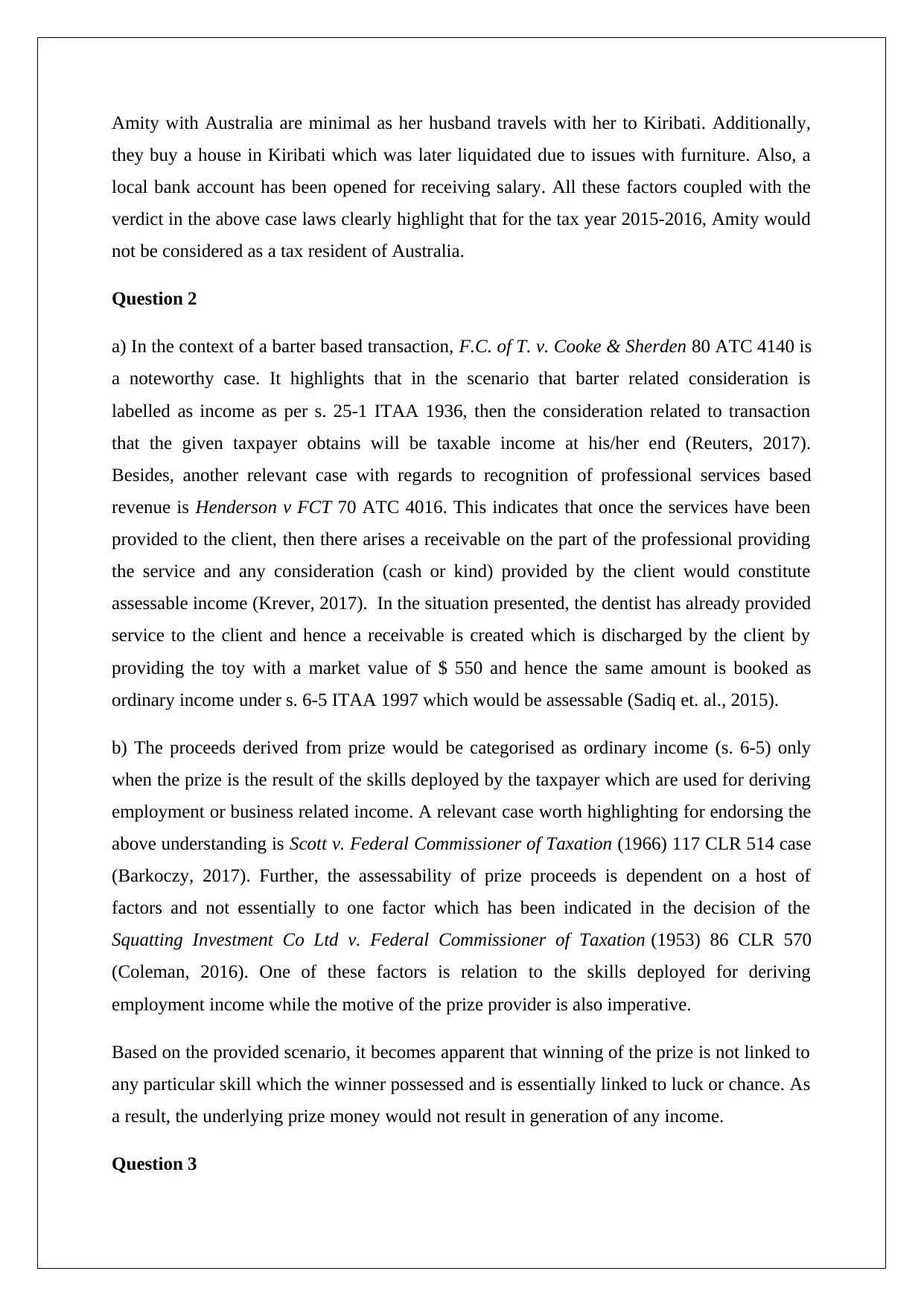
Amity with Australia are minimal as her husband travels with her to Kiribati. Additionally,
they buy a house in Kiribati which was later liquidated due to issues with furniture. Also, a
local bank account has been opened for receiving salary. All these factors coupled with the
verdict in the above case laws clearly highlight that for the tax year 2015-2016, Amity would
not be considered as a tax resident of Australia.
Question 2
a) In the context of a barter based transaction, F.C. of T. v. Cooke & Sherden 80 ATC 4140 is
a noteworthy case. It highlights that in the scenario that barter related consideration is
labelled as income as per s. 25-1 ITAA 1936, then the consideration related to transaction
that the given taxpayer obtains will be taxable income at his/her end (Reuters, 2017).
Besides, another relevant case with regards to recognition of professional services based
revenue is Henderson v FCT 70 ATC 4016. This indicates that once the services have been
provided to the client, then there arises a receivable on the part of the professional providing
the service and any consideration (cash or kind) provided by the client would constitute
assessable income (Krever, 2017). In the situation presented, the dentist has already provided
service to the client and hence a receivable is created which is discharged by the client by
providing the toy with a market value of $ 550 and hence the same amount is booked as
ordinary income under s. 6-5 ITAA 1997 which would be assessable (Sadiq et. al., 2015).
b) The proceeds derived from prize would be categorised as ordinary income (s. 6-5) only
when the prize is the result of the skills deployed by the taxpayer which are used for deriving
employment or business related income. A relevant case worth highlighting for endorsing the
above understanding is Scott v. Federal Commissioner of Taxation (1966) 117 CLR 514 case
(Barkoczy, 2017). Further, the assessability of prize proceeds is dependent on a host of
factors and not essentially to one factor which has been indicated in the decision of the
Squatting Investment Co Ltd v. Federal Commissioner of Taxation (1953) 86 CLR 570
(Coleman, 2016). One of these factors is relation to the skills deployed for deriving
employment income while the motive of the prize provider is also imperative.
Based on the provided scenario, it becomes apparent that winning of the prize is not linked to
any particular skill which the winner possessed and is essentially linked to luck or chance. As
a result, the underlying prize money would not result in generation of any income.
Question 3
they buy a house in Kiribati which was later liquidated due to issues with furniture. Also, a
local bank account has been opened for receiving salary. All these factors coupled with the
verdict in the above case laws clearly highlight that for the tax year 2015-2016, Amity would
not be considered as a tax resident of Australia.
Question 2
a) In the context of a barter based transaction, F.C. of T. v. Cooke & Sherden 80 ATC 4140 is
a noteworthy case. It highlights that in the scenario that barter related consideration is
labelled as income as per s. 25-1 ITAA 1936, then the consideration related to transaction
that the given taxpayer obtains will be taxable income at his/her end (Reuters, 2017).
Besides, another relevant case with regards to recognition of professional services based
revenue is Henderson v FCT 70 ATC 4016. This indicates that once the services have been
provided to the client, then there arises a receivable on the part of the professional providing
the service and any consideration (cash or kind) provided by the client would constitute
assessable income (Krever, 2017). In the situation presented, the dentist has already provided
service to the client and hence a receivable is created which is discharged by the client by
providing the toy with a market value of $ 550 and hence the same amount is booked as
ordinary income under s. 6-5 ITAA 1997 which would be assessable (Sadiq et. al., 2015).
b) The proceeds derived from prize would be categorised as ordinary income (s. 6-5) only
when the prize is the result of the skills deployed by the taxpayer which are used for deriving
employment or business related income. A relevant case worth highlighting for endorsing the
above understanding is Scott v. Federal Commissioner of Taxation (1966) 117 CLR 514 case
(Barkoczy, 2017). Further, the assessability of prize proceeds is dependent on a host of
factors and not essentially to one factor which has been indicated in the decision of the
Squatting Investment Co Ltd v. Federal Commissioner of Taxation (1953) 86 CLR 570
(Coleman, 2016). One of these factors is relation to the skills deployed for deriving
employment income while the motive of the prize provider is also imperative.
Based on the provided scenario, it becomes apparent that winning of the prize is not linked to
any particular skill which the winner possessed and is essentially linked to luck or chance. As
a result, the underlying prize money would not result in generation of any income.
Question 3
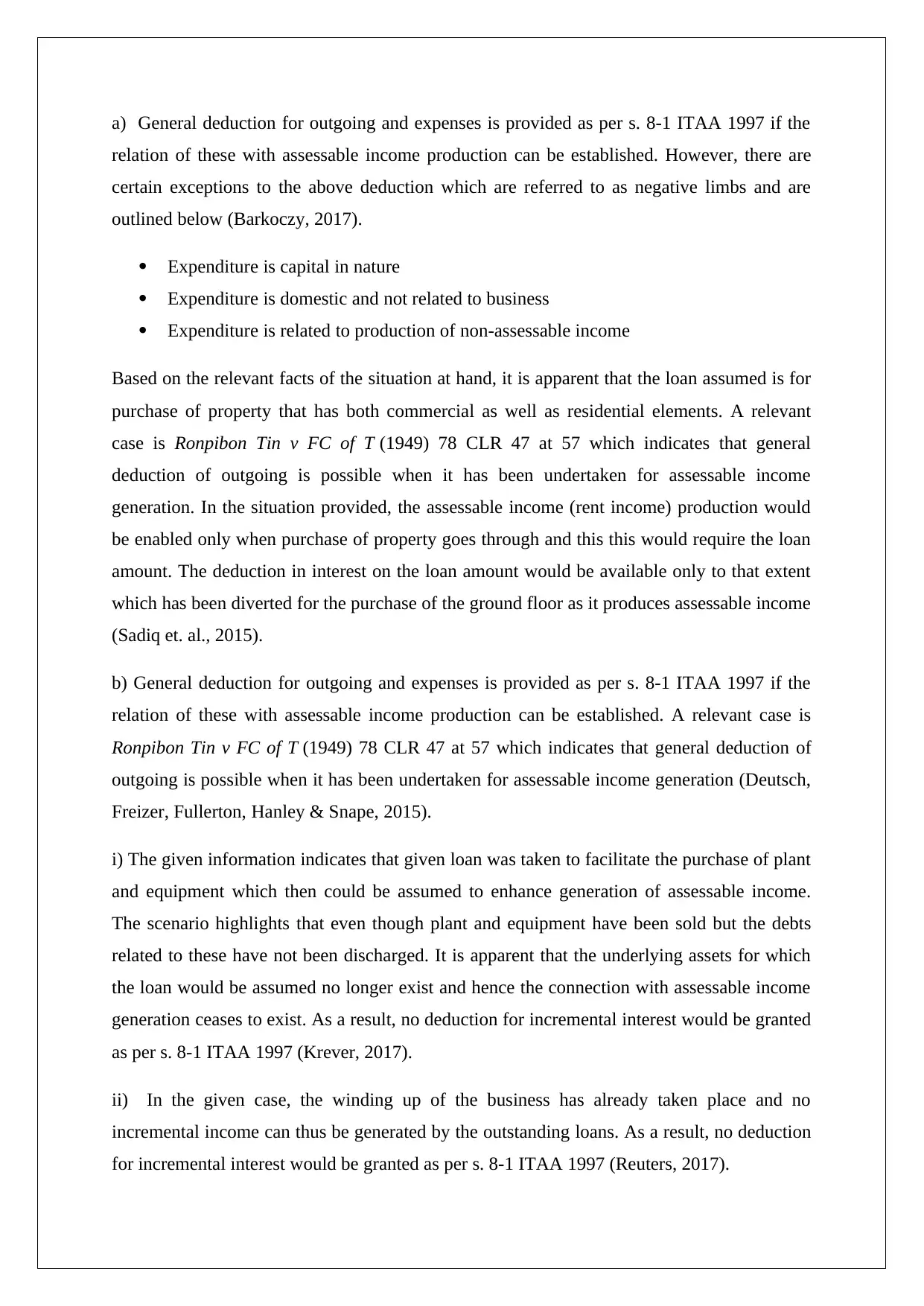
a) General deduction for outgoing and expenses is provided as per s. 8-1 ITAA 1997 if the
relation of these with assessable income production can be established. However, there are
certain exceptions to the above deduction which are referred to as negative limbs and are
outlined below (Barkoczy, 2017).
Expenditure is capital in nature
Expenditure is domestic and not related to business
Expenditure is related to production of non-assessable income
Based on the relevant facts of the situation at hand, it is apparent that the loan assumed is for
purchase of property that has both commercial as well as residential elements. A relevant
case is Ronpibon Tin v FC of T (1949) 78 CLR 47 at 57 which indicates that general
deduction of outgoing is possible when it has been undertaken for assessable income
generation. In the situation provided, the assessable income (rent income) production would
be enabled only when purchase of property goes through and this this would require the loan
amount. The deduction in interest on the loan amount would be available only to that extent
which has been diverted for the purchase of the ground floor as it produces assessable income
(Sadiq et. al., 2015).
b) General deduction for outgoing and expenses is provided as per s. 8-1 ITAA 1997 if the
relation of these with assessable income production can be established. A relevant case is
Ronpibon Tin v FC of T (1949) 78 CLR 47 at 57 which indicates that general deduction of
outgoing is possible when it has been undertaken for assessable income generation (Deutsch,
Freizer, Fullerton, Hanley & Snape, 2015).
i) The given information indicates that given loan was taken to facilitate the purchase of plant
and equipment which then could be assumed to enhance generation of assessable income.
The scenario highlights that even though plant and equipment have been sold but the debts
related to these have not been discharged. It is apparent that the underlying assets for which
the loan would be assumed no longer exist and hence the connection with assessable income
generation ceases to exist. As a result, no deduction for incremental interest would be granted
as per s. 8-1 ITAA 1997 (Krever, 2017).
ii) In the given case, the winding up of the business has already taken place and no
incremental income can thus be generated by the outstanding loans. As a result, no deduction
for incremental interest would be granted as per s. 8-1 ITAA 1997 (Reuters, 2017).
relation of these with assessable income production can be established. However, there are
certain exceptions to the above deduction which are referred to as negative limbs and are
outlined below (Barkoczy, 2017).
Expenditure is capital in nature
Expenditure is domestic and not related to business
Expenditure is related to production of non-assessable income
Based on the relevant facts of the situation at hand, it is apparent that the loan assumed is for
purchase of property that has both commercial as well as residential elements. A relevant
case is Ronpibon Tin v FC of T (1949) 78 CLR 47 at 57 which indicates that general
deduction of outgoing is possible when it has been undertaken for assessable income
generation. In the situation provided, the assessable income (rent income) production would
be enabled only when purchase of property goes through and this this would require the loan
amount. The deduction in interest on the loan amount would be available only to that extent
which has been diverted for the purchase of the ground floor as it produces assessable income
(Sadiq et. al., 2015).
b) General deduction for outgoing and expenses is provided as per s. 8-1 ITAA 1997 if the
relation of these with assessable income production can be established. A relevant case is
Ronpibon Tin v FC of T (1949) 78 CLR 47 at 57 which indicates that general deduction of
outgoing is possible when it has been undertaken for assessable income generation (Deutsch,
Freizer, Fullerton, Hanley & Snape, 2015).
i) The given information indicates that given loan was taken to facilitate the purchase of plant
and equipment which then could be assumed to enhance generation of assessable income.
The scenario highlights that even though plant and equipment have been sold but the debts
related to these have not been discharged. It is apparent that the underlying assets for which
the loan would be assumed no longer exist and hence the connection with assessable income
generation ceases to exist. As a result, no deduction for incremental interest would be granted
as per s. 8-1 ITAA 1997 (Krever, 2017).
ii) In the given case, the winding up of the business has already taken place and no
incremental income can thus be generated by the outstanding loans. As a result, no deduction
for incremental interest would be granted as per s. 8-1 ITAA 1997 (Reuters, 2017).
Secure Best Marks with AI Grader
Need help grading? Try our AI Grader for instant feedback on your assignments.
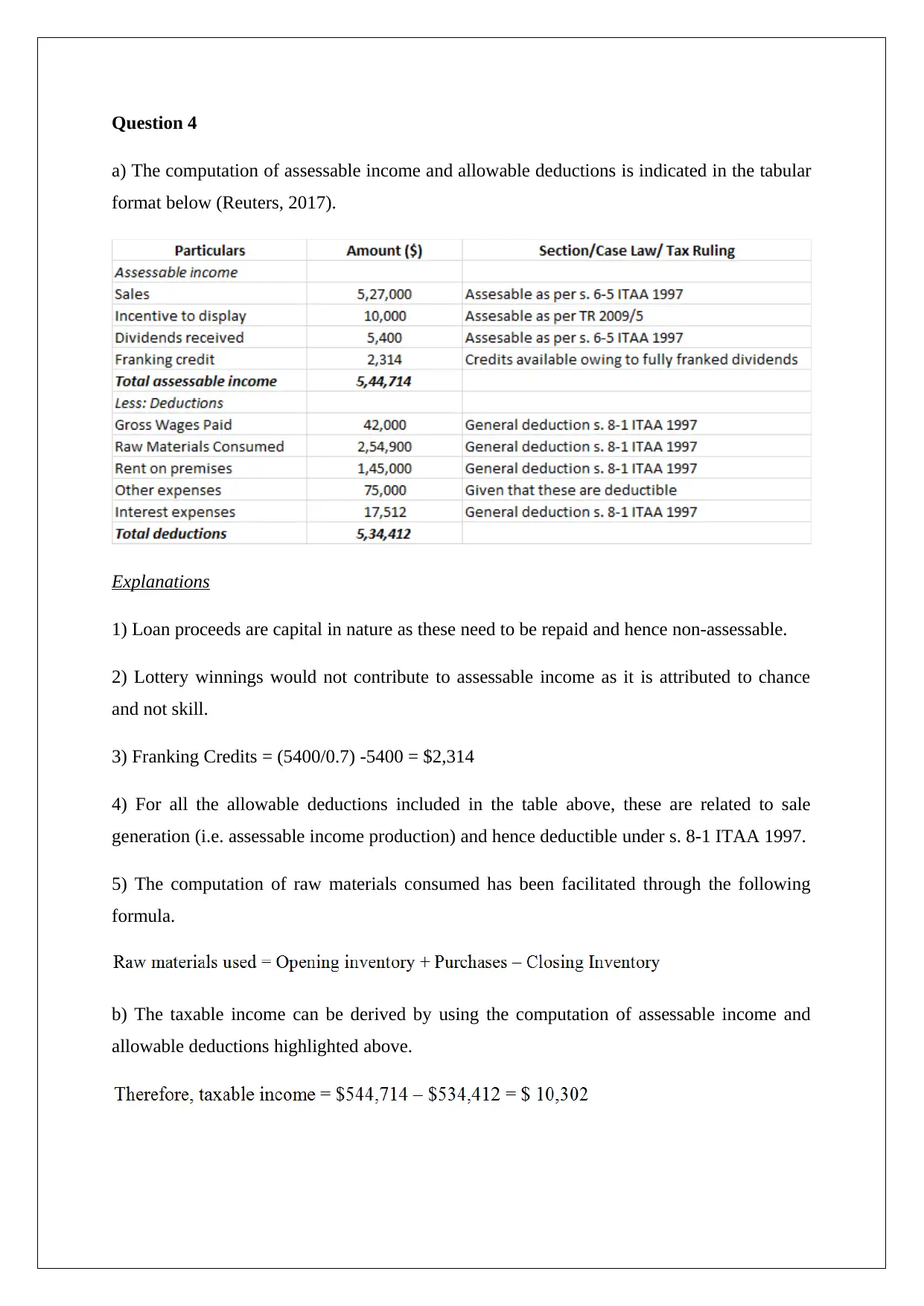
Question 4
a) The computation of assessable income and allowable deductions is indicated in the tabular
format below (Reuters, 2017).
Explanations
1) Loan proceeds are capital in nature as these need to be repaid and hence non-assessable.
2) Lottery winnings would not contribute to assessable income as it is attributed to chance
and not skill.
3) Franking Credits = (5400/0.7) -5400 = $2,314
4) For all the allowable deductions included in the table above, these are related to sale
generation (i.e. assessable income production) and hence deductible under s. 8-1 ITAA 1997.
5) The computation of raw materials consumed has been facilitated through the following
formula.
b) The taxable income can be derived by using the computation of assessable income and
allowable deductions highlighted above.
a) The computation of assessable income and allowable deductions is indicated in the tabular
format below (Reuters, 2017).
Explanations
1) Loan proceeds are capital in nature as these need to be repaid and hence non-assessable.
2) Lottery winnings would not contribute to assessable income as it is attributed to chance
and not skill.
3) Franking Credits = (5400/0.7) -5400 = $2,314
4) For all the allowable deductions included in the table above, these are related to sale
generation (i.e. assessable income production) and hence deductible under s. 8-1 ITAA 1997.
5) The computation of raw materials consumed has been facilitated through the following
formula.
b) The taxable income can be derived by using the computation of assessable income and
allowable deductions highlighted above.

A key aspect to be noted is that on the above taxable income, the tax actually paid would be
lowered by the quantum of franking credits since the dividend paying company has already
paid the same to ATO (Coleman,2016).
lowered by the quantum of franking credits since the dividend paying company has already
paid the same to ATO (Coleman,2016).
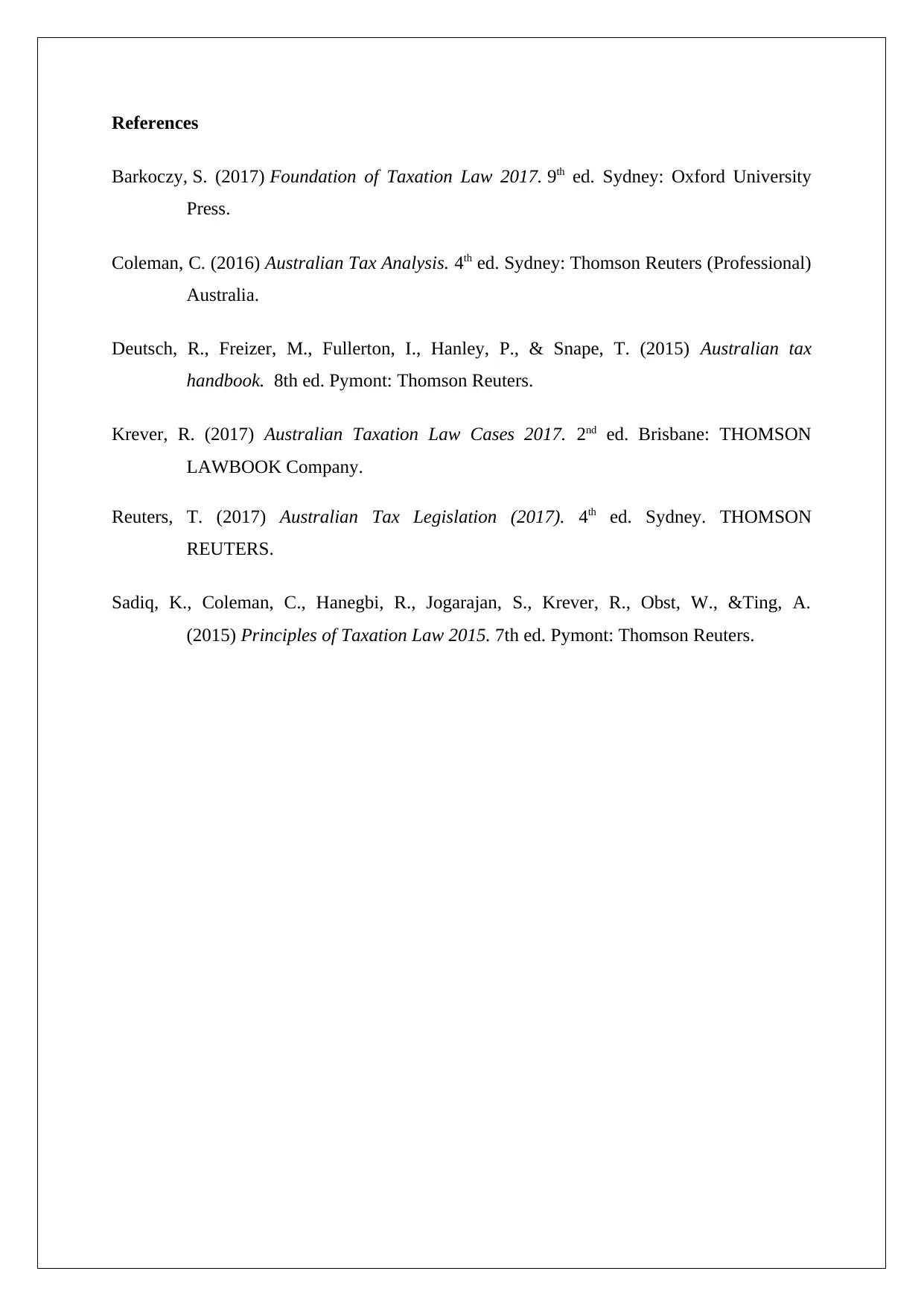
References
Barkoczy, S. (2017) Foundation of Taxation Law 2017. 9th ed. Sydney: Oxford University
Press.
Coleman, C. (2016) Australian Tax Analysis. 4th ed. Sydney: Thomson Reuters (Professional)
Australia.
Deutsch, R., Freizer, M., Fullerton, I., Hanley, P., & Snape, T. (2015) Australian tax
handbook. 8th ed. Pymont: Thomson Reuters.
Krever, R. (2017) Australian Taxation Law Cases 2017. 2nd ed. Brisbane: THOMSON
LAWBOOK Company.
Reuters, T. (2017) Australian Tax Legislation (2017). 4th ed. Sydney. THOMSON
REUTERS.
Sadiq, K., Coleman, C., Hanegbi, R., Jogarajan, S., Krever, R., Obst, W., &Ting, A.
(2015) Principles of Taxation Law 2015. 7th ed. Pymont: Thomson Reuters.
Barkoczy, S. (2017) Foundation of Taxation Law 2017. 9th ed. Sydney: Oxford University
Press.
Coleman, C. (2016) Australian Tax Analysis. 4th ed. Sydney: Thomson Reuters (Professional)
Australia.
Deutsch, R., Freizer, M., Fullerton, I., Hanley, P., & Snape, T. (2015) Australian tax
handbook. 8th ed. Pymont: Thomson Reuters.
Krever, R. (2017) Australian Taxation Law Cases 2017. 2nd ed. Brisbane: THOMSON
LAWBOOK Company.
Reuters, T. (2017) Australian Tax Legislation (2017). 4th ed. Sydney. THOMSON
REUTERS.
Sadiq, K., Coleman, C., Hanegbi, R., Jogarajan, S., Krever, R., Obst, W., &Ting, A.
(2015) Principles of Taxation Law 2015. 7th ed. Pymont: Thomson Reuters.
1 out of 7
Related Documents
Your All-in-One AI-Powered Toolkit for Academic Success.
+13062052269
info@desklib.com
Available 24*7 on WhatsApp / Email
![[object Object]](/_next/static/media/star-bottom.7253800d.svg)
Unlock your academic potential
© 2024 | Zucol Services PVT LTD | All rights reserved.





